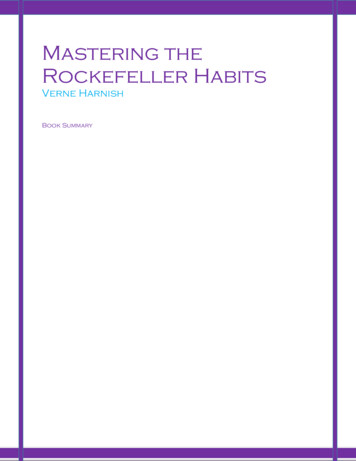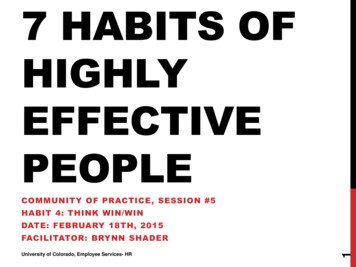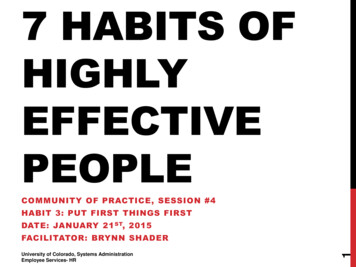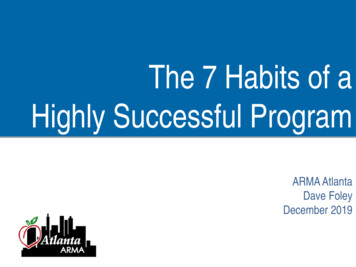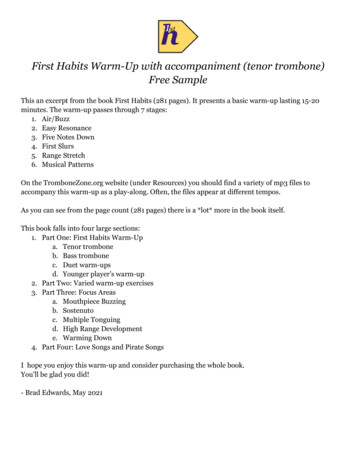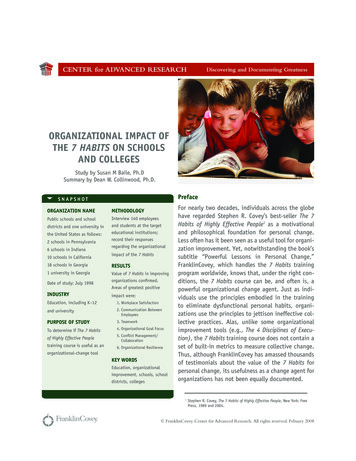
Transcription
CENTER for ADVANCED RESEARCHDiscovering and Documenting GreatnessORGANIZATIONAL IMPACT OFTHE 7 HABITS ON SCHOOLSAND COLLEGESStudy by Susan M Baile, Ph.DSummary by Dean W. Collinwood, Ph.D.PrefaceSNAPSHOTOrganization NameMethodologyPublic schools and schoolInterview 140 employeesand students at the targeteducational institutions;record their responsesregarding the organizationaldistricts and one university inthe United States as follows:2 schools in Pennsylvania6 schools in Indiana10 schools in Californiaimpact of the 7 Habits18 schools in GeorgiaResults1 university in GeorgiaValue of 7 Habits in improvingorganizations confirmed.Areas of greatest positiveDate of study: July 1998Industryimpact were:Education, including K–121. Workplace Satisfactionand university2. Communication BetweenEmployeesPurpose of Study3. TeamworkTo determine if The 7 Habits4. Organizational Goal Focusof Highly Effective People5. Conflict Management/Collaborationtraining course is useful as an6. Organizational Resilienceorganizational-change toolKey WordsEducation, organizationalimprovement, schools, schooldistricts, collegesFor nearly two decades, individuals across the globehave regarded Stephen R. Covey’s best-seller The 7Habits of Highly Effective People1 as a motivationaland philosophical foundation for personal change.Less often has it been seen as a useful tool for organization improvement. Yet, notwithstanding the book’ssubtitle “Powerful Lessons in Personal Change,”FranklinCovey, which handles the 7 Habits trainingprogram worldwide, knows that, under the right conditions, the 7 Habits course can be, and often is, apowerful organizational change agent. Just as individuals use the principles embodied in the trainingto eliminate dysfunctional personal habits, organizations use the principles to jettison ineffective collective practices. Alas, unlike some organizationalimprovement tools (e.g., The 4 Disciplines of Execution), the 7 Habits training course does not contain aset of built-in metrics to measure collective change.Thus, although FranklinCovey has amassed thousandsof testimonials about the value of the 7 Habits forpersonal change, its usefulness as a change agent fororganizations has not been equally documented.Stephen R. Covey, The 7 Habits of Highly Effective People, New York: FreePress, 1989 and 2004.1 FranklinCovey. Center for Advanced Research. All rights reserved. Febuary 2008
However, from time to time, research-based evidence of the positive organizational impact of the7 Habits appears. Such was the case when, in 1997,California University of Pennsylvania started aseries of training sessions in FranklinCovey’s 7 Habits course. For her dissertation, Joyce A. Hanley, adoctoral student at a nearby university, studied theeffects of the training on the faculty, staff, and students. She found statistically significant (p .001)perceptions of positive change in behavior on allseven habits and documented widely recognizedimprovements in the campus’s culture.2Likewise, in a study involving several schools andcolleges in the United States, Susan M. Baile, asenior consultant at FranklinCovey and former professor of communications at the University of Hartford, found credible evidence that training in the7 Habits can and does produce positive improvements in the organizational culture of schools andcolleges. Baile’s study was completed in July 1998under the title “A Qualitative Study of the Impactof Training in the Seven Habits of Highly EffectivePeople on Educational Organizations.”3 What follows is a summary of Baile’s methodology and findings.The MethodologyBaile initially identified 12 schools, school districts, and colleges where the 7 Habits had beentaught to “relatively high percentages” of teachers, professors, staff, and administrators. She thenconducted telephone interviews to determine ina preliminary way whether or not these campuseshad experienced organizational changes as a resultof the training. Six schools or districts were eliminated because they could not meet the criterion.The resulting six subject organizations representedschools comprised of students and employees ofvarying social class and racial backgrounds. Somewere urban, some were rural; some were small, somewere large. The final six schools, school districts,and universities included in the study were:Blacklick Valley School District in central western Pennsylvania. The two schools involvedwith the 7 Habits training were Blacklick ValleyJunior/Senior High School with about 450 students, and the Elementary Center with approximately 390 kindergarten through sixth grade(K–6) students.Concord Community Schools Corporation nearGoshen, Indiana. Included were four elementaryschools, one junior high school, and one seniorhigh school serving over 4000 students.Santee School District northeast of San Diego,California. The district’s schools included one K–6school and nine K–8 schools, with a total studentpopulation of 8400.Floyd County Schools in the foothills of theAppalachian Mountains in northwest Georgia. Thedistrict serves approximately 9500 students andemploys more than 1100 administrators, teachers, and support staff in ten elementary schools,two middle schools, four high schools, and onevocational/technical high school.West Side Elementary School in Marietta, Georgia. West Side is the smallest of six elementaryschools in the Marietta City School System andserves 450 children.Joyce A. Hanley, “The Effects of 7 Habits Training on Perceived Changeat California University of Pennsylvania,” doctoral dissertation, IndianaUniversity of Pennsylvania, unpublished manuscript, 2004.2 Susan M. Baile, “A Qualitative Study of the Impact of Training in theSeven Habits of Highly Effective People on Educational Organizations,”FranklinCovey, unpublished manuscript, July 1998.3 FranklinCovey. Center for Advanced Research. All rights reserved. Febuary 20082
Georgia State University. Georgia State is anurban university in the heart of downtown Atlanta,Georgia. The Building Services department wasthe unit of the campus that was included in the 7Habits study. Building Services consisted of threeunits: custodial, grounds, and campus services.Once these six organizations were selected, Bailethen visited the campuses and conducted indepth, on-site interviews with some 140 individuals. Among the interviewees were classroom andresource teachers, guidance counselors, students,secretarial/support staff, superintendents andassistant superintendents, board members, custodial staff and supervisors, program directors, and avariety of administrative staffers. All intervieweeshad completed the 7 Habits training. Interviewsranged in length from 15 minutes to 1 hour, and allinterviews were audiotaped and subsequently transcribed.The resulting 1376 pages of transcriptions wereanalyzed, and comments were notated and categorized by type of perceived impact on the organization. Baile allowed respondents to say whateverthey wished about the organizational influence(or lack thereof) of the 7 Habits and presumed nothing, positive or negative. Baile recognized that itwould be entirely possible that an organizationaleffect attributed to the 7 Habits could have beencaused by some other influence. But Baile tookrespondents at their word; if a person said that the7 Habits had been responsible for a specific organizational change, then she accepted the statementat face value, thus allowing those “on the ground”in an organization to interpret their world as theysaw it.ResultsInitially, 18 impact categories emerged from therespondents’ comments, but many of them werelater found to be overlapping in substance. Combining the redundant categories produced a set ofsix distinct categories—that is, six organizationalconditions that interviewees believed had beenimpacted in some way by the 7 Habits training. Thesix impact categories Baile documented were:1. Workplace Satisfaction2. Communication Between Employees3. Teamwork4. Organizational Goal Focus5. Conflict Management/Collaboration6. Organizational ResilienceWorkplace SatisfactionAs the famous Western Electric Hawthorne Studies4 showed in the 1920s and 1930s, workplacesatisfaction is dependent on many factors, including such things as the color of paint on officewalls and the intensity of lighting in work areas.Baile’s interviews showed that workplace satisfaction in the educational organizations she studieddepended largely on interpersonal relations. Specifically, interviewees told her that because of the7 Habits, the school and college workplace environment had become more emotionally positiveand less stressful. Further, interviewees believedWestern Electric, Western Electric Hawthorne Studies, Harvard University,various years.4 FranklinCovey. Center for Advanced Research. All rights reserved. Febuary 20083
that workers were more emotionally connected toone another and that the organizations as a wholewere emphasizing the value of work/life balancemore than before the 7 Habits training.Comments from respondents on workplace satisfaction included the following from a Santeeschool teacher: “I think [7 Habits] developed apositive attitude throughout the entire schooldistrict. It seemed that before people startedgoing through this training, a lot of things had anegative impact on certain areas, and I feel thatit has really brought us a more positive attitudetowards the people and the way work is going. Ithas totally changed.”From a teacher at Concord High School: “I thinkthe staff got to the point where I think we werejust so stressed, burned out and then, all of asudden, there came this new energy and a newsense of—a new good feeling about—really working on what we do.” From a school principal: “[7Habits] brought some cohesiveness. Maybe wehad a certain amount of that, but I noticed areal tight bonding of staff while we went throughthe FranklinCovey program.” From a school boardmember: “[After the 7 Habits training] if you didn’tagree with something, the board members didn’ttake it personally. That’s a big thing that haschanged. You don’t look at it as a personal thing;you look at it as, okay, this is an idea.” From anelementary teacher who was frustrated that someof her students’ personal circumstances made itunlikely that they would succeed in school: “Onceyou realize that you’re in that situation, and thatthe root of the problem is outside your ‘Circle ofInfluence’ [a key 7 Habits principle], you movein a different direction that doesn’t involve yourpsyche so much.”Communication Between EmployeesComments from respondents on this 7 Habits impactcategory included specific references to more opencommunication, more understanding of other people’s views, more consideration for others, a greaterwillingness to be influenced by alternative viewpoints, and more trust between fellow employees.From one Blacklick Valley teacher: “I think we got“We can trust one another.That trust was not there likeit is now.”High School Principala better understanding of the people we work with.I mean, we had such a gap between the elementary and the high school. We’ve never seen them;they’ve never seen us. So during the FranklinCoveytraining we had, we were able to come together andhave discussion and see how each of us feels.”Baile reported that the most frequently mentionedexplanation for improved communication was thatthe 7 Habits had provided a common language.From a school board member: “Once we got thelanguage, then we could use it. It’s like learningto speak Italian. We learned to speak Italian, soto speak, and then when we had opportunities,we could now talk Italian freely and openly, notjust stumbling through it.” From an administratorat Concord: “Because of the language, if there’s a FranklinCovey. Center for Advanced Research. All rights reserved. Febuary 20084
conflict or something, you can talk about ‘seeking first to understand’ [a key 7 Habits concept]then they know exactly where you’re coming from.”From an administrator at Santee: “I think that Isee more of an openness in the office, and we’remuch more able to come forward with feelings orideas about different things with other employees. The lines of communication seem much better.” From a principal: “We developed a code ofethics for the first time, based off of the trainingthat we went through with FranklinCovey. And wedecided these are our standards, and this is thecode that we’re going to stay with, and we’re goingto respect this.” And finally, another principal saidof her staff: “They’ve grown, and we can trust oneanother. That trust was not there like it is now.And even now, if there isn’t trust, we’re not afraidto voice that. I don’t think we have an atmosphereanymore, in this school system, of fear and concernthat people are out to get people.”TeamworkBaile’s respondents made numerous commentsabout the increased sense of teamwork they feltafter taking the 7 Habits training. Specifically, theyreported a heightened sense of interdependenceor “we-ness,” as well as a greater commitment toshouldering personal responsibility for work assignments. They also reported an increased expectationthat other workers, like themselves, would becomemore accountable for their actions.“7 Habits has given us a sharedvision.”Teacher, Blacklick ValleyFrom a respondent at Georgia State University:[As a result of 7 Habits] the staff changed. Theychanged. It’s just like I said, it’s more of ‘us’ andnot ‘me.’” From a teacher: “We have spent waymore time in previous years complaining abouthow nobody’s going to help us. We are in it on ourown. We are all by ourselves. But we don’t feel likethat now because we came together, and we’ve got,you know, the backing of the administration andwe’re working our way toward solutions. It’s been areally big thing, just the feeling that we’re all in ittogether.” From a teacher at the Concord schools:“[7 Habits] made us individually look at ourselvesas to what our roles are here and I really believeit made us look at each one of us, ourselves, andthink, ‘How can I improve myself to make it easierfor these children?’” From an administrator: “Thething is more that our whole community has beenestablished. People don’t mind telling you whatyour faults are if it’s to improve everybody.”From a supervisor at Georgia State: “When problemsarise with the guys, normally, they would call mebecause I am the person to see to that. But nowthey are taking it upon themselves to correct theproblems. When I know about it, the problem hasbeen solved.”From a principal at Concord: “It’s also very interesting that the kids that have taken the class,or teachers who have been trained, will hold usaccountable for the material. We’ll have conflict—like with the master schedule—and we’ll say we FranklinCovey. Center for Advanced Research. All rights reserved. Febuary 20085
just can’t do this or that, and people will say, ‘Well,can’t we at least come up with a Third Alternative?’ Well, are you just going to look at them andsay, ‘No, I don’t believe in that material’?” From ateacher: “It’s easy to talk about [7 Habits] becauseit has been so effective. We’re just proactive; weplan it and we do it. It’s not that we have to clearit through the office, because they have let go of alot of power that is traditionally held by administration. It really is our job to make the decisions,carry through, and then evaluate and decide if weare going to do that again or restructure.”Organizational Goal FocusBaile found her interviewees frequently commenting on the improvement in organizational goalfocus they sensed after the 7 Habits training. Specifically, they noticed that there was a greater focuson common goals and a greater desire to prioritizein order to achieve core objectives.From a Santee administrator: “[After 7 Habits] we’refocused much more on which wall we’re working onrather than what rung on the ladder.” From a Georgia State manager: “One of the things I’ve triedto stress with all my people is that in the past,we’ve focused mainly on doing things right. That’sstill important, but now I’m trying to get people tothink about doing the right things, and I think thathas really been an important change.” One administrator noted how his team now spent the majority of their meeting times talking about long-termstrategic planning. Before 7 Habits, he said, “Wereally had, or at least we really took, very littletime to plan for the future.”From a teacher at Blacklick Valley: “More than acommon language, I think [7 Habits] has given us,first of all, a shared vision.” An elementary staffmember reported this event: The staff had beengoing “around and around” in an unsuccessfulattempt to decide how to handle the breakfast program at the school. But then, one of them, recall-ing what they had been taught at the 7 Habitstraining about “beginning with the end in mind,”reminded the others, “You know, what we’re herefor is the children. If we keep that in mind, thenI think the rest of it will work out.” Within fiveminutes of that reminder, the group had reached aworkable solution. From an administrator: “The biggest change I saw was that people got into ‘whatdo we value?’ and ‘let’s go from there.’ And that wasa big move.”Contract negotiations can often produce an acrimonious work environment. Referring to that setting,the superintendent at Blacklick Valley observed,“We all have the same objective—number one, thekids; number two, treating each other as humanbeings and creating that good, positive climatethrough interpersonal relationships. Now, whathappens when people can see that it is a contractthat both sides can live with? Maybe neither sideis totally happy, but both sides are happy with the“Now we’re interacting andmake decisions collaboratively.”School Superintendetoutcome. Did FranklinCovey do all that? I think itdid an awful lot of that. Some of the groundworkhad been laid, but we needed something to bringit together.” FranklinCovey. Center for Advanced Research. All rights reserved. Febuary 20086
Conflict Management/CollaborationBaile interviewed many respondents who had positive things to say about the impact of the 7 Habitson conflict resolution. Specifically, they reportedthat the employees at their schools were showingmore signs of effective collaborative behavior. Oneteacher said that help with conflict resolution was“one of the major things that, every time I think ofwhat FranklinCovey has done, is number one.”From a superintendent: “The interactions that [theteachers] have with one another, the collaborationthat is going on, is a change. Where before theywere operating in isolated boxes now we’re opening doors and interacting, and articulating curriculum and making those decisions collaboratively.”From a district administrator involved with granwriting: “Rather than saying one school’s goingto get more than the other, or one school’s goingto do better than the other, they saw themselvesas sister schools who could make more improvement by coming together. And they’re doing thatnow.” From an elementary principal: “Well, before[7 Habits], a lot of the decisions that had to bemade, I just made, and told those people that itaffected. It would always come back that someoneelse was affected that I didn’t realize, and that kindof fouled things up.” He went on to state that hehad begun to share decision making in the contextof staff meetings in which everyone could participate.From the West Side principal: “There was a shiftsomewhere in the 7 Habits training. I began toassume good faith out of a meeting. It probablycame out of the ‘win-win’ [a key 7 Habits concept] part.” From a school secretary: “I feel thatthe management here has drastically changed interms of working for win-win solutions. Now whenwe go into problems, we’re both looking for whatcan make everyone feel respected when we’re done,and I think it has worked.” From a teacher: “I think“7 Habits had a drastic effecton the behavior of the kids.We reduced violence 88percent.”High School Principalwin-win is now an option that we didn’t considerbefore. I know this year I have been on a schoolwide committee to choose a social studies textbook for next year. And finding a win-win solutionmeant that we chose different companies for different grade levels, because we couldn’t find onecompany’s textbook that would have met the needsof every elementary grade level.”From a special-education teacher who described theatmosphere with parents at a series of tense meetings: The meetings were “very high anxiety andvery confrontational, with a high sense of urgency”on the part of the parents and the advocate theyhad brought in. [After 7 Habits], the meetings hadevolved to the point that the parents no longer feltthe need for an advocate; and once, when the special-education teacher had arrived late for a meeting, the child’s father, who she had expected might FranklinCovey. Center for Advanced Research. All rights reserved. Febuary 20087
be upset by her late arrival, had instead stoodup and walked around the table to welcome herwarmly.7 Habits training had strengthened their schoolsand helped them implement change without losing focus.Baile recorded several instances in which interviewees reported improvements in how they handledparental complaints as a result of the 7 Habits.One principal explained: “What I do have this yearis fewer parents coming to me to complain aboutteachers and I think that some of that is perhapsthat they are more satisfied with the treatmentthey have gotten, and they feel less like they haveto go to someone else.”From a superintendent: “I would have to say thatit was the FranklinCovey training that we all wentthrough that helped make that [change] process move the way that it did it’s just a generalsense of creating a climate that I think effectuateschange.” From the assistant director of BuildingServices at Georgia State: “We’re doing things thattraditionally shake some people’s foundations, andwe get results that other people in our organizationcan’t right now. And we’re primed to do really greatthings. I mean, I see it. I envision it. I know it’llhappen.” From a teacher involved in a plan to bus67 of their elementary students to tutor youngerchildren in two other schools: “If you haven’t studied Covey, you don’t know that that’s not a nicething to do; we tackled an enormous thing andto even conceive of that was an enormous thing.”From a district board member involved in constantchange-related decision making: “I go to most ofthe seminars and conventions and so forth, and Italk to other board members, and I start tellingthem about our board, they don’t even believe me.They say it couldn’t happen on a board, and I say,‘Well, it certainly does.’”From a high school principal: “Our behavior hasimproved drastically. The first year this administration took over, we reduced violence in our building88 percent. We had up to 65 kids the year beforewho were suspended for fighting, and we droppedour numbers down from 65 to 8 or 10 kids.” Heacknowledged that several factors contributed tothe improvement, but concluded, “There’s no doubtin my mind [7 Habits] had a drastic effect on thebehavior of the kids.” Many teachers also reportedchanges in how they handled misbehaving childrenin the classroom, citing an increased interest intrying to understand the problem from the child’sperspective before enacting some kind of disciplineor solution to the problem. From a teacher andunion leader: “Well, I would wager this is one ofthe few school districts in the state, maybe even inthe nation—it just seems like we have an extraordinarily unique situation—where I know I can goin with the superintendent and negotiate a contract. Now, for teachers to feel that strongly abouttheir superintendent and the way everybody interacts, I think is a pretty positive thing.”Organizational ResilienceOrganizations faced with (often externally imposed)changes tend to lose a sense of control. The organizational confidence to move ahead seems to wane.Baile’s interviewees reported, by contrast, that the FranklinCovey. Center for Advanced Research. All rights reserved. Febuary 20088
From an administrator who had been involved incontract negotiations involving the politicallycharged topic of class-size reductions: “Havingbeen employed in this district for 22 years, I wassitting in my office last summer when [the contractnegotiations] were occurring, and I was in awe,just in awe of the fact that people were puttingso much time dedicated to doing something goodbeyond themselves for the district and the children. And I honestly sat there and looked acrossthe parking lot, and said, ‘Wow, that is magnificent.’” Concurring with his assessment, a teacheradded: “That was super, and we could never havedone that before [7 Habits], and I have never, everseen anything energize the public school systemlike that.” Another said of the same event: “It’sjust a whole different way, and I think the mind-setis probably the best leftover that we have, becauseit just feels like ‘bring us another problem—we canhandle it!’”“I have fewer parents coming tome to complain about teachers.”School Principalleges, participants reported significant functionalimprovements in six areas: (1) workplace satisfaction,(2) communication between employees, (3) teamwork,(4) organizational goal focus, (5) conflict management/collaboration, and (6) organizational resilience.The responses Baile analyzed endorse the utility ofthe 7 Habits for improving organizational culture.An administrator from Concord told of a highlyregarded high school teacher who stood up in ameeting and said, “This is the best training I’veever had in all my educational experiences. I’ve gotmy bachelor’s and I’ve got my master’s, and I’ve gotsome coursework beyond my masters, and I’ve gotten more out of this training than anything sinceI’ve been in education.” Having experienced thework conditions in a school where the 7 Habits principles had been “ingrained in the culture,” anotherteacher summed up her feelings by declaring: “I’mnot willing to go back to the old ways.” Thus, forthe schools and colleges included in this study,there is a strong perception by the participantsthat the 7 Habits, when taken by large numbersof employees and supported by the administration,has the power to improve organizational culturein ways important to teachers, students, parents,administrators, and district board members.ConclusionAuthorsBaile found that in the six organizations she studied, respondents overwhelmingly made positivecomments about the perceived impact of the 7Habits training on the organization. Indeed, Bailereported no negative comments about the 7 Habits training in the schools under study. We do notknow why the six schools not selected for inclusion in the study could not report organizationalinfluences from the 7 Habits. No doubt, individuals who had taken the training experiencedchanges in their personal approach to the workplace, but for some reason, the organizations as awhole could not affirm an institutionwide impact.However, for the remaining schools and col-Dr. Susan M. Baile holds a Ph.D. from the University ofKansas and a master’s degree from the University of Colorado. She was a professor of communications at boththe University of Hartford and the University of Colorado.Before joining FranklinCovey as a senior consultant, sheworked with M. Scott Peck (The Road Less Traveled) todevelop training programs for such organizations as AT&T,General Motors, IBM, and the Library of Congress.Dr. Dean W. Collinwood (Ph.D. Chicago, M.Sc. London) isexecutive director of the Center for Advanced Research atFranklinCovey. FranklinCovey. Center for Advanced Research. All rights reserved. Febuary 2008CFR080053 Version 1.0.69
7 Habits can and does produce positive improve-ments in the organizational culture of schools and colleges. Baile’s study was completed in July 1998 under the title “A Qualitative Study of the Impact of Training in the Seven Habits of Highly Effective

